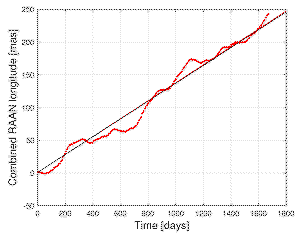Post
Circling the Drain
4 October 2012
If you’ve ever watched water drain from a bathtub you’ve seen that it doesn’t flow into the drain in a straight line, but rather swirls around the drain. Contrary to popular belief, this is not due to the rotation of the Earth, but rather random currents in the water. The reason the spiral forms is because it is self-reinforcing. Water near the drain spirals a bit due to a random current, which drags the water behind it slightly in the same direction. Over time the motion builds up until you have a rapid spiral around the drain.
There is a similar effect with space and time. I’ve talked before about how gravity is due to a curvature of space and time. The presence of mass bends space around it, and the resulting curvature means that objects follow curved paths rather than straight ones. As a result an object’s motion near a large mass like the Earth looks as if it is due to a force, which we call gravity.
 David M. Lucchesi, et al.
David M. Lucchesi, et al.It turns out that the rotation of a mass also distorts space and time. For example, as the Earth rotates it drags the nearby space along with it (an effect known as frame dragging). Just like the drain spiral, this effect builds up, and as a result space spirals a bit around the Earth. You have to be a bit careful with this comparison. Spacetime doesn’t “flow” the way water does, but the spiral effect is somewhat similar.
Near the Earth this frame dragging is very small, but it can be measured through an effect known as the Lense-Thirring effect. Basically you put a gyroscope in orbit, and see if its axis of rotation changes. If there is no frame dragging, then the orientation of the gyroscope shouldn’t change. If there is frame dragging, then the spiral twist of space and time will cause the gyroscope to precess, and its orientation will slowly change over time.
We’ve actually done this experiment, and you can see the results in the figure above. The red dots represent the change in orientation over time, and the black line is the predicted change via the Lense-Thirring effect. As you can see, they agree very well.
So the next time you watch water circling the drain, you will know that a similar effect occurs with space and time itself.